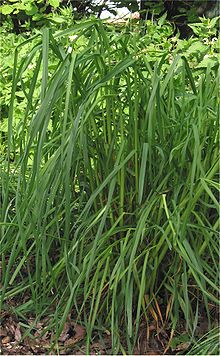- Dactylis glomerata
-
For the Candlemass album, see Dactylis Glomerata.
Dactylis glomerata 
Scientific classification Kingdom: Plantae (unranked): Angiosperms (unranked): Monocots (unranked): Commelinids Order: Poales Family: Poaceae Genus: Dactylis Species: D. glomerata Binomial name Dactylis glomerata
L.Dactylis glomerata, Cock's-foot and orchard grass, is a common species of grass in the genus Dactylis, native throughout most of Europe, temperate Asia, and northern Africa.[1][2][3][4]
Contents
Distribution
Dactylis glomerata occurs from sea level in the north of its range, to as high as 4,000 m altitude in the south of its range in Pakistan.[5] It is widely used for hay and as a forage grass.[4]
It is a principle species in the UK National Vegetation Classification habitat community the very widespread MG1 (Arrhenatherum elatius grassland), and thus can be found where Arrhenatherum elatius, (also known as False Oat grass), occurs.[6].
It can be found in meadows, pasture, roadsides, and rough grassland.
It has been introduced into North America, New Zealand and Australia, and is now widely naturalised.[7] In some areas, it has become an invasive species. Other names include cocksfoot, cocksfoot grass, and (in cultivation in the USA) orchard grass.
Description
Cock's-foot grows in dense perennial tussocks to 20–140 centimetres tall, with grey-green leaves 20–50 cm long and up to 1.5 cm broad, and a distinctive tufted triangular flowerhead 10–15 cm long, which may be either green or red- to purple-tinged (usually green in shade, redder in full sun), turning pale grey-brown at seed maturity. The spikelets are 5–9 mm long, typically containing two to five flowers. It has a characteristic flattened stem base which distinguishes it from many other grasses.[2][4]
It flowers from June to September.[8]
Taxonomy
Dactylis glomerata is treated as the sole species in the genus Dactylis by some authors,[1][3] while other authorities accept an additional one to four species in the genus.[9] It is commonly divided into several regional subspecies, particularly by those authors accepting only the single species:[1][5][9]
- Dactylis glomerata subsp. glomerata. Widespread; described from Europe.
- Dactylis glomerata subsp. altaica. Central Asia.
- Dactylis glomerata subsp. himalayensis. (syn. D. himalayensis). Western Himalaya.
- Dactylis glomerata subsp. hispanica (syn. D. hispanica). Mediterranean, SW Asia.
- Dactylis glomerata subsp. ibizensis. Balearic Islands.
- Dactylis glomerata subsp. judaica
- Dactylis glomerata subsp. juncinella. Spain.
- Dactylis glomerata subsp. lobata (syn. D. glomerata subsp. aschersoniana, D. aschersoniana, D. polygama). Central Europe.
- Dactylis glomerata subsp. lusitanica. Portugal.
- Dactylis glomerata subsp. marina (syn. D. marina). Western Mediterranean region, Iberia, Canary Islands.
- Dactylis glomerata subsp. reichenbachii. Italy.
- Dactylis glomerata subsp. santai
- Dactylis glomerata subsp. slovenica. Central Europe.
- Dactylis glomerata subsp. smithii (syn. D. smithii). Macaronesia.
- Dactylis glomerata subsp. woronowii (syn. D. woronowii). Russia.
Dactylis glomerata subsp. glomerata and subsp. hispanica are tetraploid forms with 28 chromosomes; some of the other subspecies, including subsp. himalayensis and subsp. lobata are diploid, with 2n = 14. Hexaploid forms with 42 chromosomes are also known, but rare. [3][10] Tetraploid forms are larger and coarser than diploid forms.[10]
Cultivation and uses
Cock's-foot is widely used as a hay grass and for pastures because of its high yields and sugar content, sweeter than most other temperate grasses. In dry areas such as much of Australia, Mediterranean subspecies such as subsp. hispanica are preferred for their greater drought tolerance.[11]. It requires careful grazing management - if it is undergrazed it becomes course and unpalatable.
In some areas to which it has been introduced, Cock's-foot has become an invasive weed, notably some areas of the eastern United States.[9]
As with other grasses, the pollen can cause allergic rhinitis (hay fever) in some people.
Cock's-foot is sold in small containers at a height to about 10-15 cm labelled as "cat grass" for indoor cats to eat.[citation needed]
Butterfly foodplant
Butterflies whose caterpillars feed on Cocksfoot include:[12]
- Meadow Brown Maniola jurtina
- Wall Brown Lasiommata megera
- Gatekeeper Pyronia tithonus
- Large Skipper Ochlodes venata
- Essex Skipper Thymelicus lineola
- Small Skipper Thymelicus sylvestris
- Zabulon Skipper Poanes zabulon
- Speckled Wood Pararge aegeria
References
- ^ a b c Flora Europaea: Dactylis glomerata
- ^ a b Interactive Flora of NW Europe Dactylis glomerata (Cock's-foot)
- ^ a b c Flora of China: Dactylis
- ^ a b c FAO factsheet: Dactylis glomerata
- ^ a b Flora of Pakistan: Dactylis glomerata
- ^ BSBI False Oat grass Description retrieved 10 December 2010.
- ^ Plants of Hawaii: Dactylis glomerata (cocksfoot)
- ^ Grasses by C E Hubbard, 1978, published by Penguin books
- ^ a b c Germplasm Resources Information Network: Species Records of Dactylis, http://www.ars-grin.gov/cgi-bin/npgs/html/taxon.pl?13114 Dactylis glomerata
- ^ a b Míka, V., Kohoutek, A., & Odstrèilová, V. (2002). Characteristics of important diploid and tetraploid subspecies of Dactylis from point of view of the forage crop production. Rostlinná Výroba 48 (6): 243–248. Full text
- ^ NSW Department of Primary Industries PrimeFacts: Cocksfoot
- ^ Natural England: Cocksfoot - Dactylis glomerata
Categories:- Pooideae
- Forages
- Butterfly food plants
- Bunchgrasses of Europe
- Flora of Algeria
- Flora of Egypt
- Flora of Morocco
- Flora of Afghanistan
- Flora of Cyprus
- Flora of Iran
- Flora of Iraq
- Flora of Israel
- Flora of Syria
- Flora of Turkey
- Flora of Armenia
- Flora of Azerbaijan
- Flora of Georgia (country)
- Flora of Russia
- Flora of Mongolia
- Flora of India
- Flora of Pakistan
- Flora of Denmark
- Flora of Finland
- Flora of Ireland
- Flora of Norway
- Flora of Sweden
- Flora of the United Kingdom
- Flora of Germany
- Flora of Estonia
- Flora of Latvia
- Flora of Lithuania
- Flora of Italy
- Flora of Romania
- Flora of France
- Flora of Portugal
- Flora of Spain
- Invasive plant species
- Invasive plant species in the United States
- Invasive plant species in California
Wikimedia Foundation. 2010.

